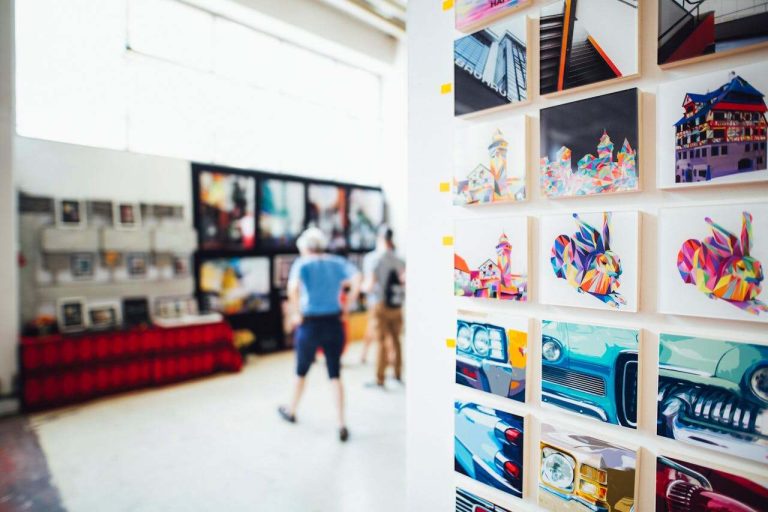The Visual Arts Internal Assessment is a crucial component of the IB curriculum. As an IB writer and tutor, I’ve seen how choosing Visual Arts IA topics can make or break your overall score. That’s why I am giving you some original ideas to consider for the SL and HL levels.
What Is the Visual Arts Internal Assessment?
From my experience, the Internal Assessment in Visual Arts course represents a significant opportunity for IB students to express their unique artistic vision and rigorously engage with and contribute to the visual arts. The IA comprises three integral components at both the SL and HL levels: the comparative study, the process portfolio, and the exhibition.
Firstly, the comparative study demands an analytical approach, where you must dig into the intricacies of artworks by different artists. This component encourages a scholarly engagement, prompting you to draw connections and contrasts between artistic expressions and cultural contexts. It’s a chance to develop and showcase your understanding of art within a global framework.
The process portfolio is your artistic logbook. It chronicles your creative path, documenting your experiments and progressions in art. This portfolio is a collection of artworks and a narrative of your evolving artistic process, demonstrating your willingness to experiment and your ability to reflect upon and refine your work.
The exhibition is where theory meets practice. It is your opportunity to curate a personal gallery of your artwork. This component assesses your ability to present a coherent collection of works that reflect a culmination of your skills and conceptual developments. The exhibition lets you make a personal statement through your chosen pieces and gives insight into your growth as an artist.
In addition, the assessment criteria evaluate your analytical, creative, and technical skills across these components. Understanding and meeting these criteria is critical to excelling at the SL and HL levels. They measure both your artistic and technical abilities and your ability to critically engage with and contextualize your work within the broader art world.
So, the IA in IB Visual Arts is a comprehensive exercise that prepares you for professional artistic engagement and academic pursuits in the arts. It requires creativity, critical thinking, and commitment to personal and academic growth.
How to Choose Visual Arts IA Topics?
Here are some steps and tips on choosing a suitable IA topic that aligns with your interests and meets IB criteria.
1. Reflect on Your Interests
Start by considering your interests and passions in the field of visual arts. Think about the styles, themes, and mediums most excite you. Engaging with a topic that genuinely interests you will make the IA process more enjoyable and meaningful.
2. Research Contemporary and Historical Art
Broaden your understanding by researching both contemporary and historical art. This approach inspires new ideas or provides a different perspective on familiar subjects. Look at influential artists, movements, and trends in art history that resonate with your creative style or challenge your current understanding.
3. Consider Available Resources
Evaluate the resources available to you, such as materials, tools, and access to local galleries or museums. Your topic choice might be influenced by what is practically accessible, whether specific art materials, digital technology, or artworks available for study.
4. Discuss Ideas with Teachers and Peers
A common mistake in writing IA is underestimating the importance of initial planning. Start early and revise often, seeking feedback from peers and instructors to refine your work. Teachers can offer advice on how manageable a topic is or how well it fits the IB criteria, while peers might share different viewpoints or suggest areas of collaboration.
5. Consider Different Cultures and Perspectives
Incorporating diverse cultural perspectives can enrich your project and demonstrate a deeper understanding of the global context of art. Consider how different cultures approach similar themes or research a cultural tradition not your own to bring a unique angle to your work.
Visual Arts IA Topics and Research Questions
Choose a topic you feel passionate about and confident in managing through the IA process. Remember, the best option is one that meets the academic criteria and also inspires and challenges you as an artist.

Standard Level (SL) Visual Arts IA Topics
SL students must develop a strong artistic voice and demonstrate good technical skills but with slightly less complexity regarding techniques’ conceptual depth and breadth. Consider these Visual Arts IA Topics for the SL level:
- The Evolution of Landscape Painting. How have landscape paintings evolved in the Western world since the 17th century?
- Art and Social Media. How does Instagram influence contemporary art practices?
- Street Art as Social Commentary. In what ways does street art reflect societal issues in urban environments?
- The Role of Women in Renaissance Art. How were women portrayed in Renaissance art, and what does this say about their societal roles at the time?
- Photography as a Documentary Tool. How effective is photography in documenting social change compared to traditional art forms?
- Surrealism and the Subconscious. What does Surrealism reveal about artists’ interpretations of the subconscious mind?
- Abstract Expressionism. How did Abstract Expressionism change the public’s perception of art in the 20th century?
- Environmental Art and Sustainability. How do environmental artists promote sustainability through their works?
- The Impact of War on Art. How did World War II influence European art movements?
- Art Therapy and Mental Health. How can art therapy be used to support mental health in adolescents?
- Cubism and its Impact on Modern Art. How did Cubism challenge traditional perspectives in art?
- Pop Art and Consumer Culture. How does Pop Art critique consumer culture and mass media?
- Indigenous Art Forms. How do indigenous art forms reflect the culture and history of their people?
- Digital Art and Technology. How has digital technology expanded the boundaries of art?
- Fashion Illustration as an Art Form. What role does fashion illustration play in bridging art and fashion?
- Expression of Emotions through Color in Paintings. How do artists use color to express emotions, and what are some notable examples?
- The Role of Art in Public Spaces. What is the significance of public art in community engagement and urban aesthetics?
- Influence of Art Deco on Modern Design. How has Art Deco influenced modern architectural and interior design trends?
- Traditional Textiles and Modern Fashion. How are traditional textiles being preserved or transformed in contemporary fashion?
- The Intersection of Music and Visual Art. How does visual art enhance our understanding and enjoyment of music?
- Art Movements Inspired by Nature. Which art movements have drawn significant inspiration from nature, and what are their key characteristics?
- The Rise of Performance Art. What are the origins of performance art, and how has it evolved in the contemporary art scene?
- The Art of Collage. How do artists use collages to create complex visual narratives?
- Art and Healing. How is art used in healing and therapeutic settings to enhance mental health?
- Evolution of Portrait Photography. How has portrait photography evolved with technological advancements in the field?
- Graffiti as Legitimate Art. How has graffiti transitioned from being considered vandalism to being respected as a legitimate art form?
- Art Influences in Video Game Design. How do traditional art techniques influence modern video game graphics and design?
Before finalizing your topic, conduct a preliminary study or create experimental works. This strategy helps you gauge your interest level and the feasibility of the topic over the long term.
Buy IB IA with Full Confidentiality!
Grab your IB IA with full privacy guaranteed.
Our no-leak policy keeps your details 100% secure.

Higher Level (HL) Visual Arts IA Topics
HL students engage more critically with sources, demonstrate a more comprehensive understanding of art history, and develop a more complex research of themes and techniques. For the HL level, you can choose one of these topics:
- Art as Political Propaganda. How have governments used art as political propaganda throughout history?
- The Influence of Philosophical Theories on Art. How have existentialist philosophies influenced modern art forms?
- Gender Representation in Contemporary Art. How does contemporary art challenge traditional gender roles?
- Postmodernism and Cultural Identity. How do postmodern artists depict and express cultural identity?
- The Aesthetics of Minimalism. What philosophical principles drive the aesthetics of Minimalism in art?
- Psychoanalysis and Art Interpretation. How can Freudian theories be applied to interpret abstract paintings?
- Interactive Art and Viewer Participation. How does interactive art change the relationship between the artwork and the viewer?
- The Renaissance Influence on Modern Art. In what ways does Renaissance art continue to influence modern artists?
- Art Censorship and Freedom of Expression. How have instances of art censorship shaped public discourse on freedom of expression?
- Futurism and its Critique of Technology. How did Futurist artists address their views on technology and its impact on society?
- Expressionism and Human Emotion. How do Expressionist artists convey complex human emotions through their artworks?
- The Evolution of Sculptural Techniques. How have modern sculptural techniques evolved from traditional methods?
- Cultural Appropriation in Contemporary Art. What are the ethical considerations of cultural appropriation in contemporary art?
- Art and Artificial Intelligence. How is artificial intelligence transforming contemporary art practices?
- Symbolism in Islamic Art. What are the symbolic meanings behind geometric patterns in Islamic art?
- Deconstructivism in Architecture. How does Deconstructivism challenge traditional architectural norms, and what are its philosophical underpinnings?
- Art in Times of Political Turmoil. How have artists responded to political turmoil in their works throughout history?
- The Renaissance and Its Impact on the Scientific World. How did the art of the Renaissance period contribute to scientific findings?
- Feminism and Contemporary Art. How do contemporary feminist artists use their work to challenge societal norms and stereotypes?
- Existentialism in Modern Sculpture. How do modern sculptors use existential themes to research human existence?
- The Influence of Japanese Art on Western Artists. How have traditional Japanese art practices influenced Western artists?
- Art and the Digital Revolution. How has the digital revolution transformed traditional art forms?
- Ethics and Morality in Photography. What ethical considerations do photographers face in depicting human subjects or tragic events?
- Surrealism in the Digital Age. How is Surrealism being reinterpreted by contemporary digital artists?
- The Role of Art in Environmental Activism. How are artists using their platforms to raise awareness and advocate for environmental issues?
- Hyperrealism and its Techniques. What techniques do hyperrealist artists use to create their highly detailed works, and what does this say about the nature of art and reality?
- Art as a Tool for Social Change. How can art be effectively used for social change and community building?
Both levels require high creativity, critical thinking, and an understanding of artistic contexts. Still, HL demands a greater depth of study and a more rigorous engagement with both practical and theoretical aspects of art.
Conclusion
The Visual Arts Internal Assessment is a path of self-fulfillment and expression. Whether you choose the SL or HL level, accept the challenges and use them to fuel your creative growth. Remember that every brush stroke and sculptural detail is one step closer to a perfect grade and a personal achievement. And if you need some help with writing your IA, feel free to contact our IB experts.

Nick Radlinsky
Nick Radlinsky is a passionate educator, marketer, and management expert with over 15 years of experience in the education sector. After graduating from business school in 2016, Nick embarked on a journey to earn his PhD, fueled by his dedication to making education better for students everywhere. His extensive experience, beginning in 2008, has made him a trusted authority in the field.
Nick's groundbreaking article, published in Routledge's "Entrepreneurship in Central and Eastern Europe: Development through Internationalization," showcases his keen insights and commitment to improving the educational landscape. Guided by his motto, "Make education better," Nick's mission is to simplify students' lives and promote efficiency in learning. His innovative ideas and leadership have helped transform countless educational experiences, setting him apart as a true pioneer in his field.




